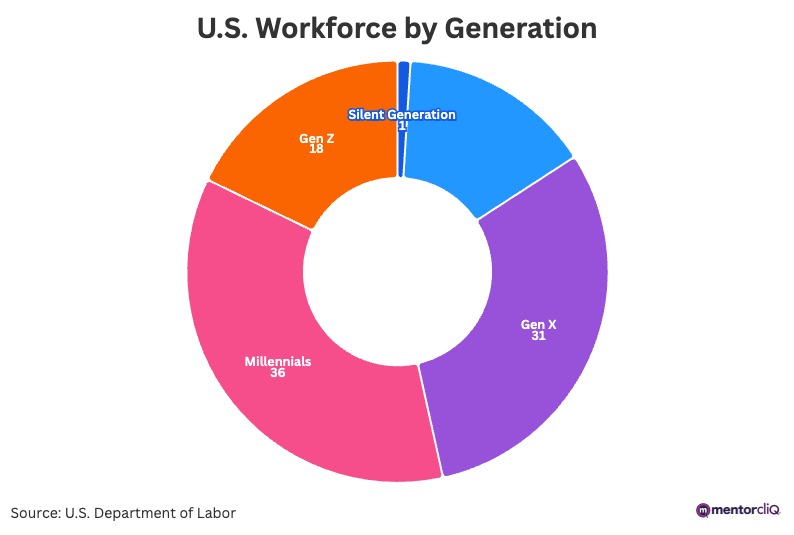A multigenerational workforce is a simple enough concept: Multiple generations all working together at the same company toward the same goal. That sounds like a kumbaya scenario, but it’s often a situation fraught with intergenerational conflict and misunderstandings. Headlines maligning various generations for their faults are enough to prove that generational gaps in both understanding and respect exist in culture, and they very often spill over into the office, as well.
It’s impossible to hire from just one generation. All generations share a place in a functioning business and will need to rub shoulders with and learn from each other to create a high-functioning workplace. When managed intentionally, a multigenerational workforce can be a major competitive edge for many organizations.
Mentoring is a crucial framework that can facilitate cross-generational information sharing, offering different generations the opportunity to value each other’s life experiences and a wide array of skills.
Here, we’ll take a closer look at:
- What generations are currently in the workplace
- The benefits different generations can bring to the table
- The challenges of generational differences to look out for
- How different generations view mentoring
- Top strategies for a high-performing multigenerational workforce
Summarize this blog post with:
What Generations Are in the Workplace?
Generational diversity is more common than ever, with most workplaces comprising multiple generational groups. The five generational groups reported in the workplace all have different communication styles, skillsets, and unique approaches to workplace challenges.
As of 2025, those five generations and their current workforce make-up include:
- Silent Generation (also known as Traditionalists): 1% of workers
- Baby Boomers (often just called “Boomers”): 15% of workers
- Generation X (more commonly called “Gen X”): 31% of workers
- Millennials (also known as “Generation Y” or “Gen Y”): 36% of workers
- Generation Z (more commonly called “Gen Z”): 18% of workers

Let’s break down each generation and their working style.
Silent Generation (Traditionalist) (1928-1945)
The Traditionalist Generation, also known as the Silent Generation, tends to align age and seniority. They often serve in senior positions of an organization, though many are now retired or in part-time work.
Baby Boomers (1946-1964)
Baby boomers are typically characterized by a deep appreciation for hard work and resilience in the face of challenge. This generation has been shaped by a competitive market; many occupy senior management or board member roles, often seeking later retirement options.
Generation X (1965-1980)
Gen Xers worked through the dot-com boom and so witnessed a huge shift in working practices. Comfortable with in-person interactions and traditional working methods, Gen Xers value teamwork and integrity from their employer.
Millennial (1981-1996)
Following Gen Xers’ example, Millennials advocate for a better work-life balance and prioritize flexibility from their workplace. Deeply valuing meaningful work, Millennials favor companies with ethical imperatives and a commitment to diversity.
Generation Z (1997-2012)
Gen Zers are progressive employees who capitalize on their digital-native upbringing. Harnessing global reach, they strive for independence in the workplace, bringing innovative digital ideas and a comprehensive understanding of new technologies.
Benefits of a Multigenerational Workforce
The opportunities for transformational mentoring are rife within a multigenerational workforce because there is so much coworkers can learn from one another. Let’s take a closer look at the multitude of benefits of working in a multigenerational workplace.
A Perfect Mix of Experience and Innovation
One of the most obvious advantages of a multigenerational workforce is the chance to blend the experience of older generations with the innovation of younger generations. If generations can embed effective communication in their day-to-day work, then businesses have the opportunity for vast growth.
Enhanced Problem-Solving
Mentoring within a multigenerational workforce can lead to enhanced problem-solving in a wide range of business areas. The collaborative impact of a cohesive team, regardless of different ages, drives up the chance for more successful problem-solving.
Future Mentoring
Leading a multigenerational workforce presents vast mentoring opportunities up and down the organizational chart. Business goals are more achievable when employees not only find common ground with one another but also learn from each other.
Multigenerational Workforce Challenges
Multigenerational workforce challenges don’t outweigh the broad range of advantages of a workforce with experience across generations, but they can cause bumps in the road when not quickly identified and effectively managed.
Different Communication Styles
Today’s workforce uses a wide array of communication tools, from staple in-person meetings and email to instant messaging and video conferencing. Such technology is fundamentally important in keeping up with the digital market, but there is research to suggest that different generations prefer different communication methods.
This can cause friction. Person A may feel most confident presenting their work over email, as they can go into depth on their findings and research, while Person B may prefer meeting face-to-face so they can hear the feedback from their peers in real-time.
Neither style is more or less effective than the other, and, in most cases, a blend of communication tools is required to communicate between teams successfully. It’s a good idea to remember the value of compromise: stepping outside your communication style comfort zone could really benefit your colleague, and you might learn valuable new skills.
Work Ethic
Much is made of the differences between the work ethic of younger employees and that of older generations. Stereotypes have spread myths that Gen Z are “lazy” or “difficult” to work with. However, these same accusations were levelled at Millennial workers only a decade ago.
Gen Z may prioritize quick, technological work that allows a good work-life balance, but this shouldn’t discredit their contribution to the workplace, especially as working in line with technological advances often gives companies a strong competitive edge.
Different generations may prefer working in different ways. Baby Boomers are known for their workaholic tendencies, while Millennials value time off to spend with family and friends. Minimizing bias around different work styles is fundamental to avoiding discontent.
Differing Expectations
Forbes highlights that the challenge of managing the expectations of a multigenerational workforce largely rests with leadership and HR teams. Understanding the main motivations at work for each generation will significantly help to create long-term strategies that meet the needs of the entire workforce. Say, what attracts Gen X to a job role could be substantially different from what attracts a Millennial. (And we’ve covered everything you need to know about employee value proposition here!)
Take into consideration the general understanding of each generation as listed above, but also be sure to respect the voice and opinion of each individual worker. A “one size fits all” approach to management for a multigenerational workforce will only lead to misalignment.
How Different Generations View Mentoring
Communication is fundamental, not just in mentoring, but in the wider workplace as well. With abundant stereotypes regarding generational communication methods, we’ll spend some time looking at the preferred ways of working for each generation.
Keep in mind, however, that this is a general overview based on annual trends. Communication is entirely unique to the individual, and you shouldn’t be surprised if some workers prefer a communication style more commonly associated with a different generation!
Traditionalists and Baby Boomers
Mentoring was ushered into the workplace in the 1980s and 1990s, largely due to the aims of diversity initiatives hoping to increase the number of women and minorities in leadership roles.
The Traditionalist generation tended to view mentoring as an obligation, particularly senior leaders who were asked to step up as mentors.
Baby boomers were more comfortable seeking out mentorship as they viewed it as a way to progress their careers.
Generation X
Gen Xers witnessed the incredible technological advancements of the 21st century, such as email and video conferencing. They pushed baby boomers to experiment with electronic communication and virtual mentoring, approaching mentoring as a collaborative process.
Millennials and Generation Z
Millennials and Gen Zers have incorporated the latest technological trends and a belief in the collaborative nature of mentoring for more inclusive and accessible mentoring dynamics. Gen Zers value the input from workers with more experience, and opt for diverse mentoring practices that will benefit their own work style and personal lives.
Actionable Strategies for a High-Performing Multigenerational Workforce
Leading a multigenerational workforce comes with unique challenges. We’ll take a look at the most effective strategies to unite a multigenerational workforce under a common purpose so all employees reach their full potential.
1. Use Mentoring Software
Consider using mentoring software to make the entire process of mentoring easier for your employees. The software pairs mentors and mentees together to help them address their learning or development goals. It’s a great way to make impartial mentoring matches. They can also use the software to set goals for their relationship and track progress toward those goals.
2. Offer Multiple Types of Mentoring
Mentoring takes many forms. From traditional one-to-one pairs and more modern reverse mentoring to broader group mentoring, there’s a mentoring format for every individual and team.
It’s common for myths about each workforce to populate social media or even the news, but don’t limit your mentoring options based on stereotypes. Providing a multitude of choices for employees takes into consideration the varying preferences of each generation, boosting employee engagement.
3. Let People Decide How They Meet and Communicate
Some employees prefer in-person mentoring meetings, while others prefer, say, a Zoom call. Some may even want to just text, while others prefer discussions over the phone. If you went by generational stereotypes, Gen Xers could be pigeonholed as using email, rather than video conferences or Slack.
However, making decisions based on inaccurate perceptions of generational workers and their communication preferences can have a damaging impact on the work environment. Allowing people the chance to make their own choices about how they communicate is far more effective.
Our Mentoring Agreement Template Has Been Viewed over 11,000 times!
Download our popular mentoring agreement template to help build a strong foundation of rapport between mentors and mentees.
4. Provide Training and Support
To help make mentoring more approachable and accessible to everyone, think about how training and support fit into the picture. Provide your employees with tips and tricks that can make their relationships a success, regardless of what generation they come from. Demystifying the mentoring process and coaching people to see beyond generational stereotypes can help workers view one another as unique human beings rather than oversimplified caricatures.
5. Cultivate Mutual Mentorship
Bringing innovative mentoring practices into a workforce is one of the best methods for cultivating knowledge sharing between generations. Reverse mentoring is one such practice, and typically functions with a junior employee mentoring a senior employee in an area where they are less experienced in.
One of the key benefits of reverse mentoring for Gen Zers is building meaningful relationships with older workers who, in turn, gain distinctive experience from learning from younger workers.
Bridging the Generational Divide With Mentoring
With so many generations working side by side, there are bound to be points of friction. How these frictions are managed is what will make the difference when it comes to establishing long-term success.
Mentoring in a multigenerational workforce gives teams the opportunity to formalize their knowledge flow, deepen their teamwork experience, and build genuine connections with their other employees. Opting for a mentoring platform is a sure-fire way of eliminating silo in your organization, establishing a more collaborative, growth-focused culture.
Ready to embrace the full advantages of your diverse team? Our #1 enterprise mentoring software is a perfect solution for addressing generational differences and connecting them for collective success. Connect with MentorcliQ to learn more!





